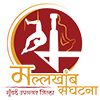
About Mallakhamb Sport
About Mallakhamb Sport
Mallakhamb originated during the reign of Bajirao Peshwa II in Pune. In the latter part of the 19th century, Ali and Gulab, two strong wrestlers from the Nijam of Hyderabad who had conquered various kingdoms, challenged Peshwa for a wrestling match at the court of Bajirao Peshwa II in Pune. Looking at the confidence of the wrestlers, their courage and preparation, none of the wrestlers in the Peshwa’s court dared to accept the challenge. To keep Peshwa’s image, Balambhattadada Deodhar, who was born in Kothure village near Nashik and gave physical training to the court of Peshwa, accepted the challenge and sought some time for preparation. After that, he went to his village i.e. Kothure near Nashik and prayed to Lord Saptashrungi Devi who is situated on Vani Hill and requested to show him a way out of the incident.



Goddess Saptashrungi Devi appeared in Balambhattadada Deodhar’s dreams on that night and blessed him that, the epitome of strength i.e. Marutirai himself would teach him wrestling techniques. On the next day, when Balambhattadada Deodhar was returning from his bath, Marutirai in the form of a mighty monkey appeared in front of him and showed him various tactics on a wooden pole for almost three days and practised by Balambhattadada. Thereafter, Balambhattadada Devdhar prepared a special pole that looked like a human body and practised various tricks on that pole as shown by Marutirai. After that, Balambhattadada Deodhar returned to Pune on the stipulated time and defeated one of the Nijam’s best Malla’s, Ali, in a few moments, using the tricks which were practised on the pole, and Gulab, another Malla, fled in fear. Since then, Mallakhamb emerged as an ancillary form of exercise for wrestling. The ‘Malla’ who wrestled and the ‘Khamb’ which is required to practice for Malla’s i.e. ‘Khamb of Malla’s’ is combinely known as ‘Mallakhamb’.
Later, wherever Balambattadada Deodhar travelled with the Peshwa, he started wrestling arenas and established Mallakhamb in the arenas. Balambhattada Deodhar started arenas in Pune, Varanasi, Baroda, Surat, Bhopal, Ujjain, Dewas, Indore, Jhansi, Gwalior, etc. and promoted Mallakhamb along with wrestling.
Following is the tentative chart of information about Balambhattadada Deodhar’s disciples during this journey.

In the book ‘Mansollas’ written by Someshwara Chalukya in the year 1135 AD, Mallakhamb is mentioned with some pictures of the exercises on the pole. Mallakhamb training is said to have been carried on through lineage since its establishment in the Jagannath Vallabh Akhada, which began in the fifteenth century, next to the ancient temple of the famous Jagannathpuri in Orissa.

Father of the Mallakhamb
Mallakhamb Sizes, Types and Benefits
Mallakhamb has many shapes and types, but the most commonly used mallakhamb is made of shisava or teak wood. The structure of this pole is similar to the human body, followed by the head on top, then neck and the body below it, and this pole tapers upwards. Therefore, the spherical part at the top like the human head is the bond, below that is the neck and below that the part up to the crown is the body. There are various groups of exercises on Mallakhamb including adhi, tedhi, phirki, vel, suidora, catches, farare, asana, mount and dismount jumps, balancing positions, etc. There are also different types of mallakhamb, such as Pole mallakhamb, Hanging mallakhamb, Rope mallakhamb, Vet mallakhamb, Niradhar mallakhamb, Bottle mounted mallakhamb, Sugarcane mallakhamb, Weapon mallakhamb, Fire mallakhamb, Pyramid mallakhamb, etc. The three types such as Pole, Hannging and Rope Mallakhamb are used as Competitive Mallakhamb. At present, Mallakhamb competitions are held at District, State, National and International levels.
Mallakhamb is an ancient Indian sport and various exercises on Mallakhamb help in the growth and development of the human body such as strength, agility, flexibility, control of balancing movement, courage, concentration, etc. All in all, Mallakhamb is a traditional sport that reliably promotes a healthy lifestyle through the all-around physical/educational/intellectual development of a person.

Pole (Fixed) Mallakhamb

Hanging Mallakhamb

Rope Mallakhamb
In this variation, the player performs exercises on a rope suspended from a support at the top. The rope is typically 5.5 metres (18 ft) long, and approximately 1 to 2 centimetres (0.39 to 0.79 in) in diameter. The rope is caught by the player in the gap between the toes, along with hands. After climbing upwards on the rope, the player performs various asanas, balancing positions, catches in stipulated time. Players are expected to perform various exercises without knotting the rope in any way.
Special benefits of Malla-Khamb
Benefits of Malla-Khamb
Flexibility
Develop the necessary range of motion and suppleness required for mastering the intricate movements.
Coordination
Enhances stability and control, reducing the risk of falls or injuries while performing.
Core Strength
Provides the foundational stability and support necessary for executing various poses.
Mental Focus
Develop greater self-awareness, concentration, and enabling them to perform while underpressure.
